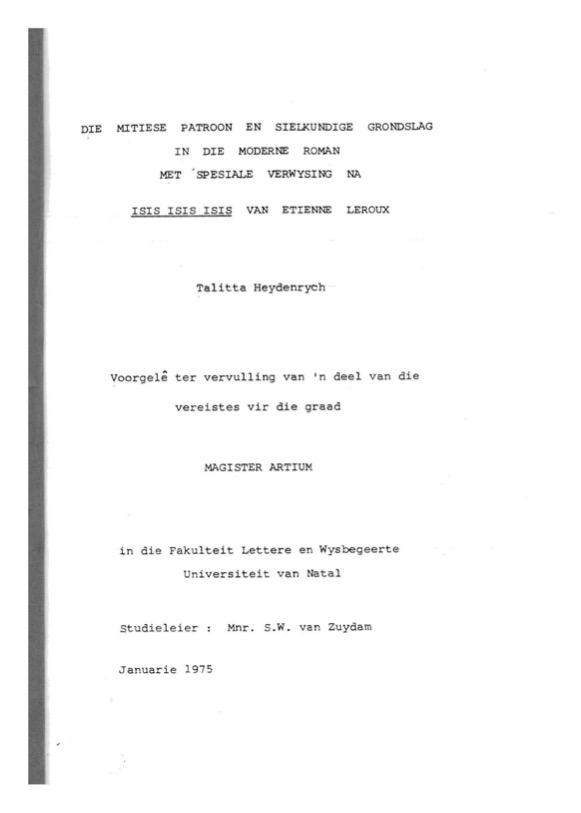-
Title
-
Die mitiese patroon en sielkundige grondslag in die moderne roman met spesiale verwysing na Isis Isis Isis van Etienne Leroux
-
author
-
Heydenrych, Talitta
-
datePublished
-
1975
-
degree
-
Magister Artium
-
publisher
-
Universiteit van Natal
-
department
-
Fakulteit Lettere en Wysbegeerte
-
contributor
-
Van Zuydam, S. W.
-
description
-
Although the main character in the novel, a writer who calls himself "Mr Y", describes his decision to undertake a trip to Europe as quite "normal", the sub-title - "a story of thirteen women and a description of an inward journey" - suggests that there is much more to this "pleasure trip" than he initially seems to admit. As in most of his previous novels, Leroux uses the myth as the main vehicle for conveying what he has to say. In Isis Mr. Y is almost obsessed with the old Egyptian myth of Isis and Osiris, and he sees himself in a similar predicament to that of the old Osiris. The point of departure is his concept of the disintegration of his soul and his search for Isis, the only force able to put him together again: "My soul is in fragments and I lie scattered in fourteen pieces over the oceans. In ancient, mystical times Isis searched the whole world to mend Osiris; in the modern merry-go-round of the soul Osiris searches for an Isis to bring him together." However, Mr. Y's story cannot merely be described as analogous to the pattern set by the archetypal myth. There are two significant changes. The roles of Isis and Osiris are reversed - the quest of Isis now becomes a the quest of the "dead" Osiris. And it is the soul of Osiris that has been destroyed. According to Mr. Y, his reversal of the old myth must be attributed to the age in which we live: "Perhaps it is a sign of our time: that the dead Osiris should be searching for the living Isis". He also says: "I am part of our time, and my whole existence is an accusation against our time if one should be inclined to blame the time for things that we do not understand". But although he is very much part of the twentieth century (for example in his language, and his way of life), and although he is in fact modern man in search of the "living myth", his intense desire to be "reborn" can be considered as one of the primordial affirmations of mankind. He bases his story on the one particular myth of Isis and Osiris, but he also explores other mythologies. He refers to the function of "mythos" within society, and to the Jungian concept of the myth as being a direct expression of the collective unconscious. He also refers to various esoteric teachings (the Holy Quabalah, alchemy, the Tarot) in his attempt to discover something of the truth about man. Mr. Y is in a state of spiritual confusion, but he is also conscious of the fact that, as an artist functioning within society, he might be able to be the discoverer of a "new myth" - something which would be of value to the whole of mankind. As far as the myth of Isis and Osiris is concerned, there is much less of Leroux's previous obscurity. As soon as Mr. Y sets out on his "inward journey" in a Boeing 707, he starts "explaining" about the myth, Jung, alchemy, the Tarot - sometimes under the most unlikely circumstances, and with extremely comical results. This rationalization of the mythical might also be seen as a sign of our times. But beneath all Mr. Y's carelessness and nonchalance, there is the intense desire which man has always experienced to reconcile the contradictions in life as well as those within the self. He is not only Mr. Y who was (physically) beaten up by his lover's jealous husband, but everyman, who, through the ages, has tried in all sorts of ways to come to terms with life. It is because of his interest in the soul of man that he explores the wisdom of the ages to be found in mythology, the Quabalah, and the Tarot. Despite its apparent flippancy, Isis is therefore the depiction of an "alchemical journey" by which Mr. Y, the "charlatan", is trying to find the "elixir of life". It also has certain psychological, political and social dimensions, but basically three levels of interpretation can be singled out: The actual journey - Mr. Y - Negro - women; The mythological search - Osiris - Set - Isis; The psychological journey - Self - shadow - anima. The myth of Isis and Osiris is the framework out of which Mr. Y's journey grows, and he gives us a modern version of the old myth. But on the other hand the mythological level, with its archetypal images, is extended to the psychological level, and the search for Isis and the lost fragments becomes the depiction of an attempt to reach spiritual "wholeness". However, these levels of interpretation can hardly be considered separately. They are: ...the two handmaids which rarely exist apart when stream of consciousness notation is employed: mythical parallels and psychic phenomena.
-
keywords
-
Isis Isis Isis, 1969
-
Leroux, Etienne
-
inLanguage
-
Afrikaans
-
numberOfPages
-
130
-
fileFormat
-
PDF

